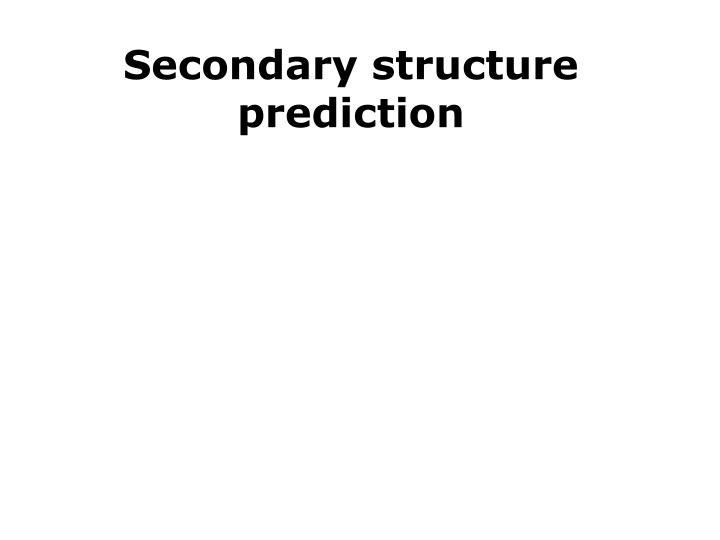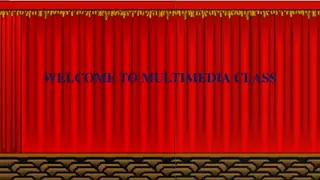
Advanced Techniques for Secondary Structure Prediction in Protein Analysis
Explore the world of secondary structure prediction in protein analysis, including the prediction accuracy, limitations, applications, and techniques like neural networks and evolutionary trees. Learn about Jnet neural network training, network structure, and signal propagation. Discover how these methods help locate functionally important residues, find structural units, and more.
Download Presentation

Please find below an Image/Link to download the presentation.
The content on the website is provided AS IS for your information and personal use only. It may not be sold, licensed, or shared on other websites without obtaining consent from the author. If you encounter any issues during the download, it is possible that the publisher has removed the file from their server.
You are allowed to download the files provided on this website for personal or commercial use, subject to the condition that they are used lawfully. All files are the property of their respective owners.
The content on the website is provided AS IS for your information and personal use only. It may not be sold, licensed, or shared on other websites without obtaining consent from the author.
E N D
Presentation Transcript
Secondary structure prediction
Secondary structure prediction Amino acid sequence -> Secondary structure Alpha helix Beta strand Disordered/coil 70% accuracy 1991, 81% accuracy in 2009
Secondary structure prediction Limits: Limited to globular proteins Not for membrane proteins
Secondary structure prediction Applications Site directed mutagenesis Locate functionally important residues Find structural units / domains
Secondary structure prediction Techniques Linear statistics Physicochemical properties Linear discrimination Machine learning Neural Networks K-nearest neighbours Evolutionary trees Residue substitution matrices Using evolutionary information = Multiple sequence alignments.
Secondary structure prediction Jnet Cuff and Barton (2000) Neural Network Training set: 480 proteins (non homologous) Construction of MSA for each using BLAST
Secondary structure prediction Jnet Neural network Ni Neuron i, Nj neuron j Wij weight from Ni to Nj Wij Ni Nj Signal forward propagation Output from Ni * Weight Ni to Nj Input to Nj is Ij = Oi * Wij
Secondary structure prediction Jnet Neural network Ni Neuron i, Nj neuron j Wij weight from Ni to Nj Wij Ni Nz Output layer Nj Nk Input layer
Secondary structure prediction Jnet Neural network The network receives input values Ii Ni Wiz Wjz Ij Nz Output layer Nj Wkz Ik Nk Input layer
Secondary structure prediction Jnet Neural network Signal forward propagation Ii Ni Wiz Wjz Ij Oz Nz Nj Wkz Ik Nk Sum of outputs from Ni, Nj, Nk
Secondary structure prediction Jnet Neural network Compute the error Ii Ni Wiz Wjz Ij Oz Nz Nj Wkz Ik Nk Desired value is 1, Oz is 0.8 Error is = Oz desired value = 1-0.8 =0.2
Secondary structure prediction Jnet Neural network Error backpropagation Ni Wiz Wjz Oz Nz Nj Wkz Nk Weights are modified so that the result is a bit closer to what we wanted
Secondary structure prediction Jnet Neural network Hidden layer Ni Np Nj Nz Output layer Nq Nk Input layer
Secondary structure prediction Jnet Neural network A C D Y Input layer: read a sequence CTEIL...
Secondary structure prediction Jnet Neural network 0 1 0 A C D Y CDEKL... 0 Input layer: read a sequence CDEKL...
Secondary structure prediction Jnet Neural network 0 0 1 A C CDEKL... D Y 0 Input layer: read a sequence CDEKL...
Secondary structure prediction Jnet Neural network A C CDEKL... D Y Input layer: read a sequence CDEKL...
Secondary structure prediction Jnet Neural network A 1 0 a C CDEKL... b Alpha-helix D Y 0 c Output layer: structure Desired output: known structure
Secondary structure prediction Jnet Neural network A 0.4 0.6 1 0 a C CDEKL... b Alpha-helix D Y 0.1 0 c Output layer: structure Desired output: known structure
Secondary structure prediction Jnet Neural network A 0.4 0.6 1 0 a C CDEKL... b Alpha-helix D Y 0.1 0 c Error backpropagation = weights are modified
Secondary structure prediction Jnet Sequence to structure network Jnet architecture LAPEDCDEKLKLEPNAC a b c Input layer = window of 17 residues Hidden layer = 9 neurons Output layer = 3 neurons
Secondary structure prediction Jnet Jnet architecture FLAPEDCDEKLKLEPNACW ccaacaaccbbbbbcbbbc a b c
Secondary structure prediction Jnet Structure to structure network Jnet architecture ccaaaaacccbbbbbbbbc FLAPEDCDEKLKLEPNACW ccaacaaccbbbbbcbbbc a a b b c c Input layer = window of 19 residues Hidden layer = 9 neurons Output layer = 3 neurons
Secondary structure prediction Geoff Barton, University of Dundee Cole et al (2008) Nucleic Acids Research
Secondary structure prediction Jpred Uses algorithm Jnet2.0 Three state prediction Alpha, beta, coil Accuracy 81.5% (2008) But if no homolog (orphan sequence) 65.9%! PSIBLAST PSSM matrix HMMer profiles (instead of aa frequencies) Multiple neural networks 100 hidden layer units
Secondary structure prediction Jpred First, search against PDB sequences using BLAST (but only for warning) PSIBLAST search of UniRef90, 3 iterations, Alignment of hits (filtered at 75% id) Profiles from alignment (PSSM and HMMer) Profiles are input to JNet Alternative: user provides alignment (faster)
Secondary structure prediction Advanced Jpred4 usage
Secondary structure prediction Jpred output
Secondary structure prediction JPred Jpred output / Jalview
Secondary structure prediction JPred Jpred output / view all
Secondary structure prediction JPred Jpred output / PDF output
Exercise 1/3 Jalview 2D prediction Starting Jalview Open Firefox with JRE (from ZDV) Go to http://www.jalview.org Click the pink arrow Launch Jalview Desktop You can close all the demo windows that appear
Exercise 1/3 Jalview 2D prediction Load an alignment Use MR1_fasta.txt This is an alignment of a fragment of the mineralocorticoid receptor Open it from File > Input alignment > From file (Hint: You can load it directly as an URL, e.g. https://cbdm.uni- mainz.de/files/2015/02/MR1_fasta.txt) The alignment has its own Menu tabs Try Colour > Clustalx to see conservation
Exercise 2/3 Jalview 2D prediction Web service -> Secondary Structure Prediction -> Jnet secondary str pred No selection (or all sequences selected) = Jnet runs on top sequence using the alignment (fast) One sequence (or region) selected = Jnet runs on that sequence using homologs (slow) Some sequences selected = Jnet runs on top one using homologs (slow) Try with no sequences selected
Exercise 2/3 Jalview 2D prediction If this doesn t work you can run directly MR1_fasta.txt on jpred4. Use the advanced option Upload a file option Select type of input = Multiple alignment (use format FASTA) Tick the skip PDB search option There is an option to view output in Jalview
Exercise 3/3 Jalview 2D prediction Annotations: Lupas_21, Lupas_14, Lupas_28 Coiled-coil predictions for the sequence. 21, 14 and 28 are windows used.
Exercise 3/3 Jalview 2D prediction Annotations: JNETHMM, JNETALIGN: predictions using diff profiles Jnetpred: Consensus prediction. Beta sheets: green arrows. Alpha helices: red tubes.
Exercise 3/3 Jalview 2D prediction Annotations: JNETCONF Confidence in the prediction.
Exercise 3/3 Jalview 2D prediction Annotations: JNETSOL25,JNETSOL5,JNETSOL0 Solvent accessibility predictions - binary predictions of 25%, 5% or 0% solvent accessibility.
Exercise 3/3 2D prediction of known 3D Obtain the sequence of the human glutamine synthetase. Run BLAST with the human sequence against: 1) the archaea Methanosarcina 2) the bacteria Escherichia coli 3) the fungi Pseudozima Antarctica Get the best homolog, align the sequences (including the human protein, on top) and use the input in Jalview.
Exercise 3/3 2D prediction of known 3D NCBI BLAST against single species is faster!
Exercise 3/3 2D prediction of known 3D Obtain the sequence of the human glutamine synthetase. Run BLAST with the human sequence against: 1) the archaea Methanosarcina 2) the bacteria Escherichia coli 3) the fungi Pseudozima Antarctica Get the best homolog from each, align the sequences and use the input in Jalview. Put the human protein on top.
Exercise 3/3 2D prediction of known 3D Load the alignment in Jalview and run web prediction. Alternative. Run the alignment in the Jpred4 server. (Hint: You could run the human sequence alone but that will search for homologs and will take very long) Compare the prediction with the known 3D of the human protein (open it in Chimera, File > Fetch by ID > PDB 2QC8)
Exercise 3/3 2D prediction of known 3D We need to hide all chains except one. Select one of the chains (ctrl + click on a residue, then arrow up). Invert selection (press arrow right). Actions > Ribbon > Hide Actions > Atoms/bonds > Hide Select the chain and focus on it Actions > Focus
Exercise 3/3 2D prediction of known 3D Compare the output of jpred/jalview 2D pref with the 3D structure of this protein. For example, locate a predicted helix or beta-strand in Jalview. Find out the start and end positions hovering over the human sequence with the mouse (the numbers on top of the alignment are different from the amino acid positions in each sequence). Color the corresponding residues it in the 3D view using Select > Atom specifier And ranges: e.g. :113-126 (predicted as helix) Actions > color > red Apply color some helices red and strands in green. Do you see differences? Where are they? Would you say that the 2D prediction was reasonable?






















